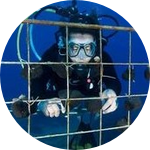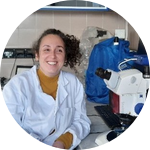About This Project
Plastic pollution poses a significant threat to marine ecosystems. Seagrass beds have been recognized as natural sinks for plastics, while Neptune balls are efficient particle traps. This pilot study seeks to explore the potential of these spherical structures as sentinels for plastic pollution along the coast of the Mediterranean Sea by analyzing their entrapment capability. We aim to introduce an innovative approach to assessing plastic pollution in marine ecosystems.
Ask the Scientists
Join The DiscussionWhat is the context of this research?
Plastic pollution is a global threat to both terrestrial and marine ecosystems. Approximately 0.5% of plastic waste enters the oceans, with a staggering 400.3 Million metric tons produced worldwide in 2022. Within marine ecosystems, plastic accumulates on the seafloor or drifts across the sea. Some ecosystems, such as seagrass meadows act as a sink for these pollutants creating islands of pollution. Additionally, Neptune balls, spherical structures formed by dead leaves, detritus, and sediment within seagrass meadows, act as traps for plastic particles. Recent studies indicate that these balls can hold up to 1,470 items/Kg. Surprisingly, the correlation between Neptune balls and plastic contamination in the same area remains unexplored.
What is the significance of this project?
The significance of this project lies in its potential to address the pressing issue of plastic pollution in marine ecosystems. By investigating the entrapment capability of Neptune balls and their correlation with plastic contamination, we aim to provide valuable insights into the dynamics of plastic pollution in coastal areas. This research not only enhances our understanding of the sources and distribution of plastic waste but also offers practical implications for monitoring and mitigating its impact on marine environments. Ultimately, our findings could inform policymakers, researchers, and communities about effective strategies for preserving marine biodiversity and safeguarding coastal ecosystems for future generations.
What are the goals of the project?
This pilot research aims to explore the potential of Neptune balls as sentinels for plastic pollution along the coasts of the Mediterranean Sea. For the first time, an integrated approach, based on analyzing the plastic entrapment capability of the spheres and the levels of plastic contamination in the same areas, will be applied.
Specific aims are:
1. Identifying hotspot areas for Neptune balls collection in the Mediterranean Sea
2. Improving microplastic extraction protocols from Neptune balls
3. Detecting plastic contamination in beach sediment within the study areas
4. Investigating the correlation between Neptune balls and plastic contamination
5. Developing standardized protocols
6. Starting a campaign to promote the reuse and recycling of seagrass fibers.
Budget
Our budget allocation significantly contributes to the progress of our research project. It allows us to establish a collaborative network of Mediterranean researchers dedicated to investigating Neptune Balls as indicators of plastic pollution. Specifically, the funds are essential for covering shipping expenses (i.e. paper boxes and glass jars used to avoid plastic contaminations of samples during the shipping process and the shipping fees) required to transport samples to our laboratory. Additionally, the funds will be used for procuring necessary laboratory materials (i.e., chemicals, boxes, glass jars, gloves), for the webpage creation and maintenance and the communication material.
This financial support plays a crucial role in facilitating the execution of our research objectives, ensuring that we can conduct thorough analyses and contribute effectively to addressing plastic pollution in marine environments.
Endorsed by
 Project Timeline
Project Timeline
Hotspots along the Mediterranean coasts rich in Neptune Balls and plastic contamination will be identified. Samples will then be collected and sent to us by local researchers. Plastic extraction will be conducted on Neptune Balls and beach sediment to discern patterns and correlations with the pollution of the area. We’ll synthesize the results using an interactive webpage and standardized protocols, significantly contributing to understanding and managing plastic pollution in marine ecosystems.
May 10, 2024
Project Launched
Nov 19, 2024
Project Launched
Jan 31, 2025
Identification of hotspots along the Mediterranean coasts
Feb 28, 2025
Creating an interactive webpage (continuously updated) to collect data on Neptune Balls' location and plastic contamination level
Mar 31, 2025
Communication campaign
Meet the Team
Team Bio
We are two researchers of the Stazione Zoologica Anton Dohrn (Italy) interested in marine ecology and pollution research. Valentina specializes in seagrass ecosystems, focusing on mapping, protecting, and restoring, while Cristina investigates marine litter pollution, particularly plastic impacts on biodiversity. Together, they want to contribute to the conservation and restoration of marine ecosystems, using an innovative approach to assessing marine plastic pollution.
Valentina Costa
My research activity is focused on the study of the ecology of seagrass marine ecosystems. The main purpose of my research is to answer ecological questions by applying an integrated approach based on three main keywords: map, protect and restore.
To map and protect any ecosystem, knowledge represents the starting point, and how different environmental variables can affect the ecosystem itself is also necessary. During my PhD, I worked on evaluating the effects of particular environmental gradients (acidification and confinement) on seagrass detritus decomposition dynamics and the colonization by marine invertebrates of the detritus itself. After my PhD, I focused my research on the effects of ocean acidification on seagrasses also using experimental approaches and mesocosm studies.
More recently, my interest has been more focused on the keyword restore. One approach to ecosystem restoration is the transplanting of organisms from non-impacted areas to areas that need to be reforested. For this reason, part of my research activity is focused on the evaluation of transplantation techniques used for marine seagrass restoration activities.
I am also very interested in new open-source technologies (e.g. Arduino) and how these can be applied to the study of the ecology of marine ecosystems.
Cristina Pedà
My research activity focuses on the study of different aspects of marine litter pollution with particular attention to the impacts of plastic on the marine ecosystems and biodiversity. During my PhD, I investigated the effects of microplastics ingestion in a commercially valuable species under controlled laboratory conditions. Then, I continued to study the plastic ingestion phenomenon in teleost and cartilaginous fish and in cephalopod molluscs as well as the potential transfer of plastics along the trophic web. To explore the issue of marine litter pollution, I also studied the presence of litter in marine different compartments and in particular its composition and abundance on the seafloor and on the sea surface, as well as the interaction between litter and marine organisms. In this view, part of my research activity is focused on the application and validation of methodologies for the microplastics extraction from different marine matrices (sediment, seawater, and biota) and polymer’s identification by Fourier transforms infrared spectroscopy (FT-IR). In the future, I would like to investigate the potential effects of plastics in sensitive habitats and also in underexplored organisms.
Additional Information
An interactive webpage will be developed to streamline the collection and dissemination of information regarding Neptune Balls collection and plastic contamination in the study area. This webpage will serve as a centralized platform where data collected from fieldwork, including Neptune Balls collection locations and plastic contamination levels, will be compiled and displayed in real time. Researchers will have the opportunity to interact directly with the data, enabling them to visualize and analyze findings effortlessly. Additionally, the webpage will feature user-friendly tools that allow users to conduct simple analyses, empowering them to draw insights and contribute to the ongoing research. This interactive platform not only enhances transparency and accessibility but also encourages active engagement and collaboration among researchers, stakeholders, and the wider community in addressing plastic pollution in marine ecosystems.
Neptune Balls are composed of fibers formed by dead leaves and detritus mixed with sediment. A campaign to raise awareness about the potential use of Neptune Balls fibers as a sustainable resource for producing biodegradable alternatives to traditional plastics will be started. It may involve educational initiatives to inform the public about the environmental benefits of using biodegradable materials and the importance of recycling Neptune ball fibers. Additionally, the campaign could promote collaboration with relevant industries and stakeholders to explore innovative methods for processing Neptune ball fibers and integrating them into biodegradable plastic or resin production processes.
Project Backers
- 1Backers
- 106%Funded
- $8,500Total Donations
- $8,500.00Average Donation




